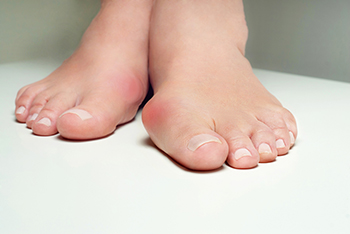

Bunions are a common foot deformity. They are easy to notice by the large, bony protrusion that forms on the side of the big toe. An additional complication that can happen from a bunion can include calluses that form as a result of the bunion hitting the side or top of the shoe. Large bunions may cause the other toes to shift toward each other, and bigger shoes may have to be purchased. Bunions are caused by genetic reasons, or from wearing shoes that do not have adequate room for the toes to move freely in. Bunions can be unsightly, and there are prevention methods that can reduce the risk of getting a bunion. These can include wearing shoes that fit correctly and minimizing stress that is put on the feet. If you have a bunion, a podiatrist can offer you effective treatment methods, and it is strongly suggested that you confer with this type of doctor who can help you to manage this condition.
If you are suffering from bunions, contact Dale Delaney, DPM of InStride Kinston Podiatry Center. Our doctor can provide the care you need to keep you pain-free and on your feet.
What Is a Bunion?
A bunion is formed of swollen tissue or an enlargement of boney growth, usually located at the base joint of the toe that connects to the foot. The swelling occurs due to the bones in the big toe shifting inward, which impacts the other toes of the foot. This causes the area around the base of the big toe to become inflamed and painful.
Why Do Bunions Form?
Genetics – Susceptibility to bunions are often hereditary
Stress on the feet – Poorly fitted and uncomfortable footwear that places stress on feet, such as heels, can worsen existing bunions
How Are Bunions Diagnosed?
Doctors often perform two tests – blood tests and x-rays – when trying to diagnose bunions, especially in the early stages of development. Blood tests help determine if the foot pain is being caused by something else, such as arthritis, while x-rays provide a clear picture of your bone structure to your doctor.
How Are Bunions Treated?
If you have any questions, please feel free to contact our office located in Kinston, NC . We offer the newest diagnostic and treatment technologies for all your foot care needs.